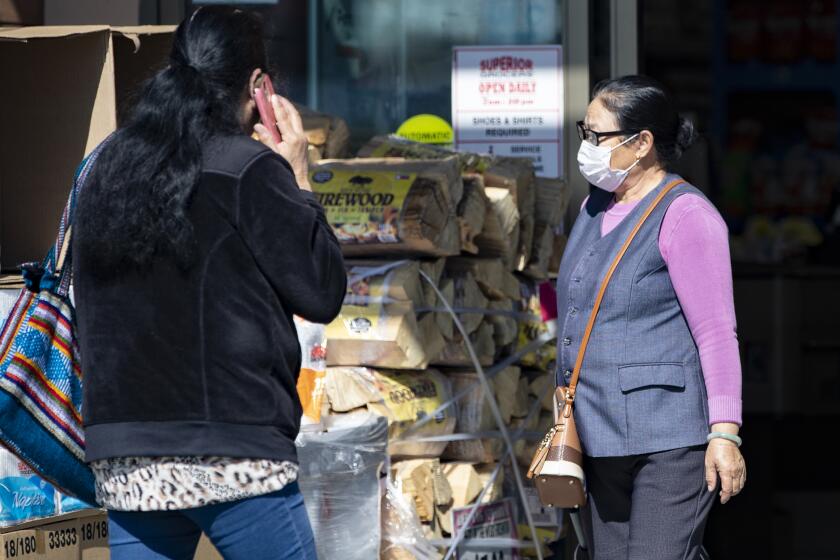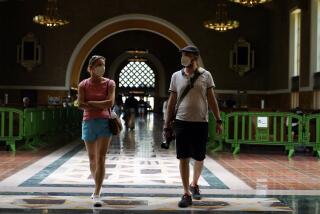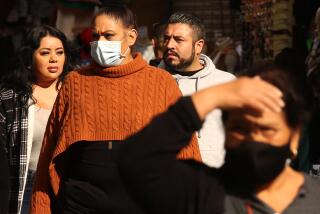From skeptics to spreading the gospel, Latinos quickly became converts to masks in war against coronavirus
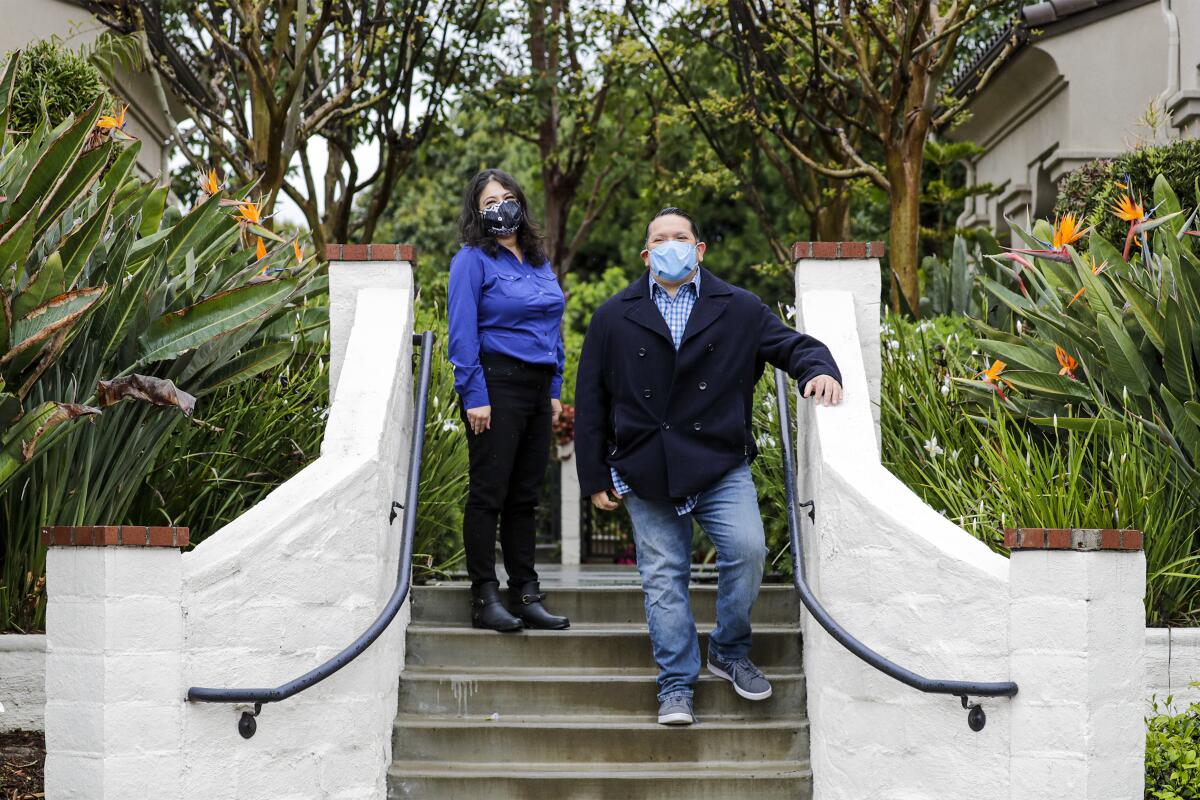
Before she began to spread the gospel of masks, Rosalina Nava was a skeptic.
Even as many of her Asian immigrant neighbors in the San Gabriel Valley increasingly wore them to protect against the growing coronavirus threat, the 42-year-old court reporter resisted wearing a mask, finding them strange and cold. In this regard, that made her typical of Latinos, the largest group in California.
But by the middle of March, even before many places started requiring masks in public, Nava and many other Latinos not only became converts to wearing — they became mask evangelists, pushing their loved ones, their partners and their co-workers to wear them.
Nava persuaded her boyfriend to wear a mask, and he in turn convinced his his aunts, uncles and cousins living in Riverside to put them on even before the county made usage mandatory on April 4.
“It was nerve-racking seeing everyone wearing these masks and not really understanding what was going on,” Nava said. “When I realized how deadly the coronavirus was, I thought it was time to turn that fear into action.”
Though incomplete and based on a limited sample, preliminary data released last week by L.A. County showed that Latinos, which make up almost half of the county’s population, represent just over a quarter of its coronavirus deaths. Experts said that the lower mortality rate could partly be due to the fact that the Latino community tends to be younger than other demographic groups.
In an area of L.A. with large Asian and Latino populations, reactions to the outbreak are varied.
But they also worried that there could be a surge in Latino deaths, pointing to such factors as relatively high poverty rates in the population, larger households and working in fields that often require them to be out of the house.
The county’s top public health official, Dr. Barbara Ferrer, cautioned against drawing conclusions based on the figures, given they were based on 57% of reported deaths. But they aligned with information released last week by Gov. Gavin Newsom’s administration, which also showed that Latino deaths statewide were smaller than their percentage of California’s population.
A Pew Research poll last month found that about two-thirds of Latino adults considered the coronavirus outbreak a major threat to the health of the U.S. population as a whole, compared with about half of the general public. Whether this has resulted in changes in social behavior — including wearing masks and taking other precautions that could lower the spread of the virus — is unclear.
“When I realized how deadly the coronavirus was, I thought it was time to turn that fear into action.”
— El Monte resident Rosalina Nava
While experts are split on the effectiveness of cloth masks, Nava has come to believe there is no downside to wearing them — and that they can only help to slow the spread of transmission.
“If you and I are in the same room and it helps me or helps you, why not use one?” she asked. “Why not flatten the curve?”
Nava purchased and sent cloth masks back to family in the Central Valley. She also convinced her hesitant boyfriend, Danny Herrera, a 42-year-old advertising agency strategist, to cover his face.
He said he had to push family members in the Inland Empire to shed their skepticism, as he had, and wear the masks.
“I have a lot of family there who weren’t really happy to put the face masks on,” Herrera said. “But now they’re all doing it and have been doing it way before Riverside County said to.”
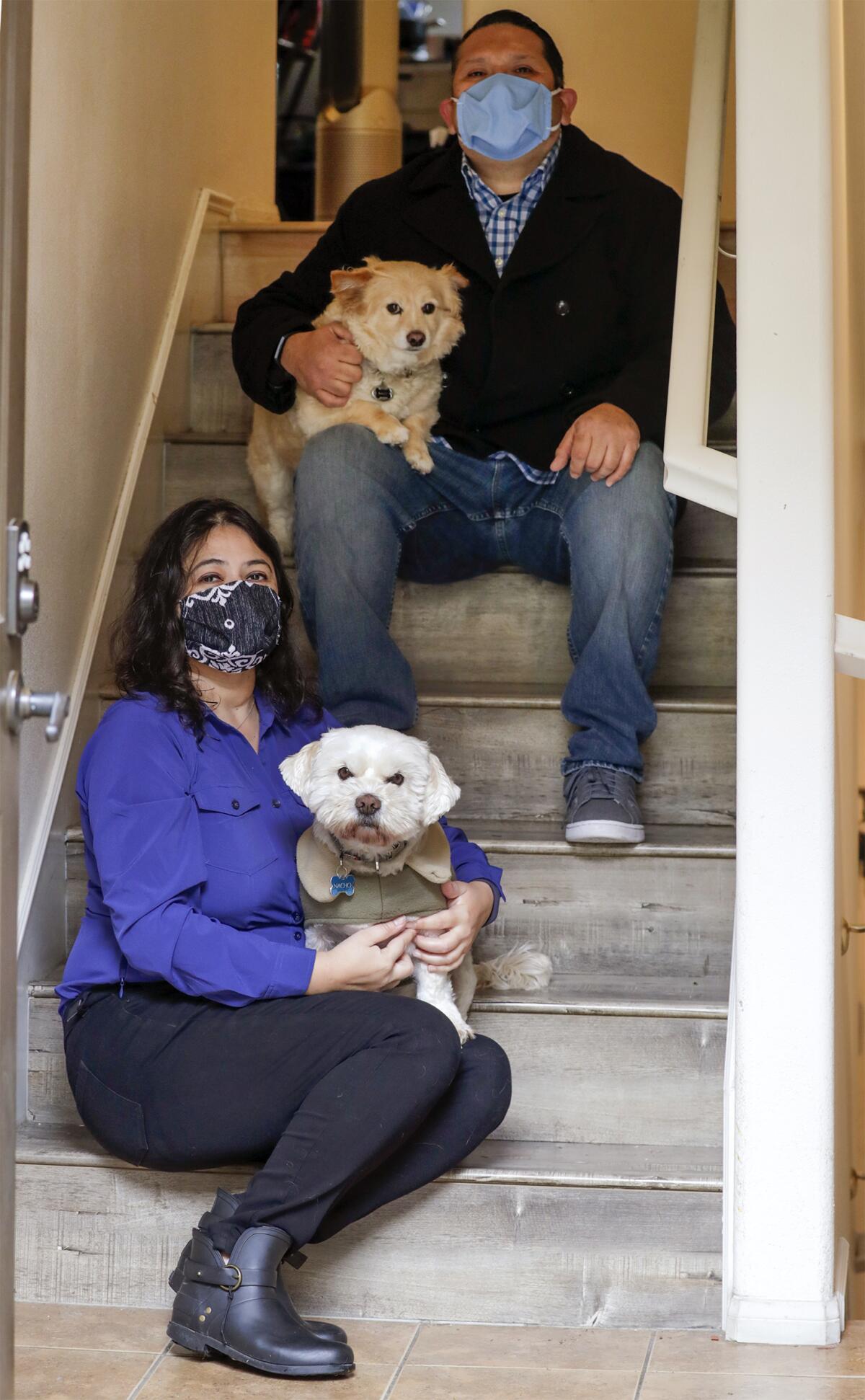
Carlos Franco, a 29-year-old produce distributor from Boyle Heights, said he realized he had to wear a mask three weeks ago while shopping at a market.
“I was in line to buy milk and the guy ahead of me coughed all over the pen that everybody uses to sign credit card slips,” said Franco, who’s seen his business, Elias Produce, struggle with sales during the lockdown.
“From then on it was like, I’m using [touchless] Apple Pay and a face mask because I don’t want to get anyone sick,” he said.
Franco said a lot of Asian co-workers and customers had been wearing the masks for months before his own conversion. But he said he found the changing guidance on them from officials confusing.
“One week it was, ‘save the mask for nurses and doctors’ and another week the experts and the media were saying that masks aren’t effective,” he said.
For weeks now, Franco said he has been pushing family and friends to use masks to fight the spread of coronavirus.
“They’re not uncomfortable at all, and now when I wear one it lets my customers know I’m serious about their safety,” he said.
Julissa Rodriguez, 28, said she has been wearing masks whenever she leaves her home in Van Nuys.
Two months ago the field representative for Assemblyman Adrin Nazarian (D-Van Nuys) would have never considered using a mask.
Rodriguez said she changed her mind when Gov. Gavin Newsom issued his stay-at-home order on March 19 that closed nonessential businesses. From that point, she understood the significance of COVID-19 and saw a change within her neighborhood.
“That weekend, all over the Valley, you saw members of the Latinx community, who play a huge role in the informal economy, selling masks for $5 on many street corners,” Rodriguez said. “The distribution of masks and their availability led many people to change their minds.”
One person who needed additional convincing was Rodriguez’s 64-year-old father.
“My dad was telling me, ‘I’m invincible’ and ‘I’m fine’ and ‘Nothing is going to happen to me,’” Rodriguez said. “I told him that this wasn’t about him. This was about protecting my mom, me and everyone in the house. He understood after that.”
More to Read
Sign up for Essential California
The most important California stories and recommendations in your inbox every morning.
You may occasionally receive promotional content from the Los Angeles Times.
